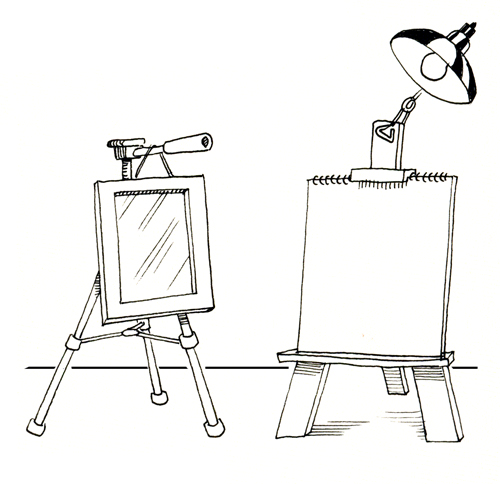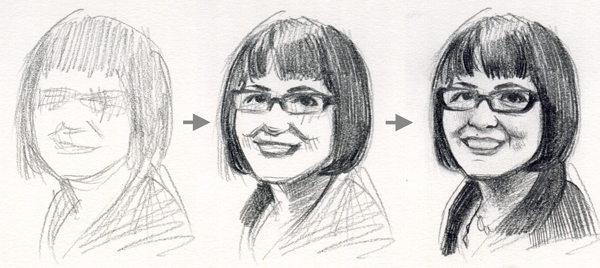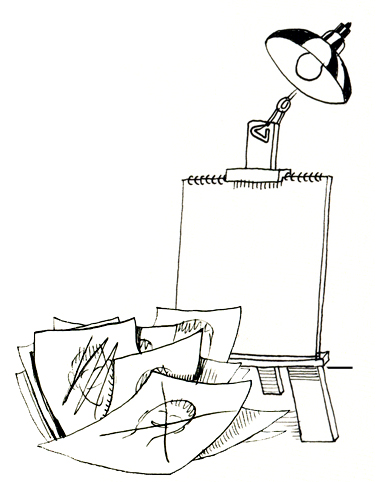When it comes to drawing portraits, we starving artists know that in a pinch, we always have access to one model absolutely free of charge: ourselves!
The self-portrait is one of the oldest traditions in art, and for good reason. Not only are you always available to pose (so long as you have a mirror), but there’s no better way to practice achieving a likeness than with the face you are most familiar.
Let’s go over some tips for drawing a great self-portrait.

Tip #1: Try to avoid only drawing from photographs
The best way to learn to draw a self-portrait is from life. After all, you’re alive! Drawing a self-portrait from life by using a mirror allows you to see what you are drawing in three-dimensions.
It becomes much easier to understand volumes and lights and darks than when you are simply looking at a flat photo. Plus, you can adjust your light source to your liking, instead of being stuck with the predetermined lighting of an already-taken photo.

Tip#2: Set up a comfortable workspace
Make sure your working conditions are optimal. Having a dedicated studio in which to make art may be a luxury for some of us, but you can still do better than balancing your sketchbook on your knee.
Set up a mirror in a place where it’s easy to see — don’t drag you drawing materials to the bathroom sink! Hanging a wall mirror on a camera tripod is a good way to keep your mirror close to your drawing surface so you’re not moving your head back and forth too much between your drawing and the mirror.
Make sure you have a good light source and that your drawing surface is near vertical, because on a flat surface, the drawing can “get away from you” and become distorted. An inexpensive table easel and a clip-on light are great for this.

Tip #3: Work general to specific
The best way to tackle something as seemingly complicated as a self-portrait is to keep it simple. Think of the biggest shapes and values — the lights and darks.
Work loosely and lightly at first, developing the correct proportions and values, gradually working your way into a detailed drawing. Don’t go for broke on drawing a realistic eye for instance, and then move on. Your whole drawing should be at the same level of development at all times. This helps you to keep thinking about the big picture, instead of focusing on the small stuff.

Tip #4: Try, try again!
Let’s be honest. There are no shortcuts to becoming a great artist. It may be a cliché, but that old adage about success being “99% perspiration” is absolutely true.
Practice, practice, practice is the name of the game. We can only learn through mistakes, and every mistake, once identified, is a step toward a better self-portrait.
So the best tip for drawing a great self-portrait is to draw as many as you can, and don’t work in a vacuum. Let other artists see what you’re doing, and talk with them about your work. Seek out criticism!
But most importantly, work. An art professor once put it this way: “Everyone has a thousand terrible works of art in them. The quicker you get rid of those, the quicker you get to the good ones.” The good news is, it’s not a thousand terrible works of art in a row. Every so often, you’ll make something great, and the more you make, the more frequently the good stuff will pop up. So draw away!
What’s your best tip for drawing a self-portrait? How many have you done?
Bring Faces to Life with Our Free Drawing Guide
Premium Membership
Unlock exclusive member content from our industry experts.
- 24/7 Access to Over 2,000 Premium Classes and Hundreds of Instructional Videos Across 20+ Categories
- Extensive Library of Downloadable Patterns and Recipes
- Stream and Download Classes Anywhere with the Craftsy App
- Share Your Membership with up to 3 Friends or Family Members
- Access to Ask the Expert Program
- Admission to Exclusive LIVE Streaming Virtual Events
Unlock exclusive member content from our industry experts.
- 24/7 Access to Over 2,000 Premium Classes and Hundreds of Instructional Videos Across 20+ Categories
- Extensive Library of Downloadable Patterns and Recipes
- Stream and Download Classes Anywhere with the Craftsy App
- Share Your Membership with up to 3 Friends or Family Members
- 2 Full-Length Classes to Keep in Your Account for Life
- Access to Ask the Expert Program
- Admission to Exclusive LIVE Streaming Virtual Events
Gold Membership
$449 Value
Get everything included in Premium plus exclusive Gold Membership benefits.
- 24/7 Access to Over 2,000 Premium Classes and Hundreds of Instructional Videos Across 20+ Categories
- Extensive Library of Downloadable Patterns and Recipes
- Stream and Download Classes Anywhere with the Craftsy App
- Share your Membership with up to 3 friends or family members
- 8 Full-Length Classes of Your Choice to Keep in Your Account for Life
- 10 Patterns, Guides, or Recipes of Your choice to Download to Your Devices
- 20% off Purchase-to-Own Classes in the Craftsy Shop (Select Classes Only)
- Access to Ask the Expert Program
- Exclusive GOLD LIVE Virtual Events


Share tips, start a discussion or ask one of our experts or other students a question.
No Responses to “4 Essential Tips for Drawing a Self-Portrait”